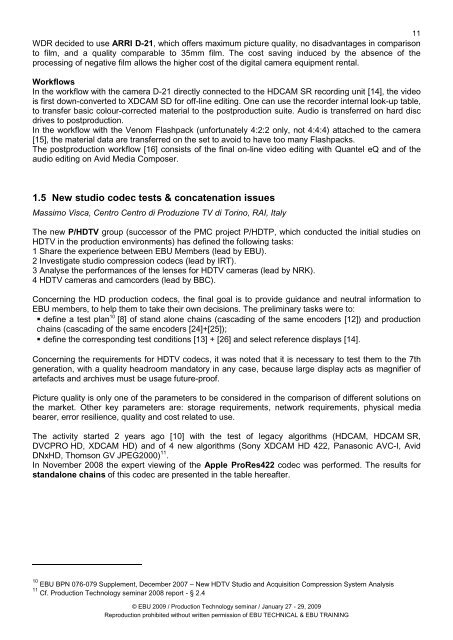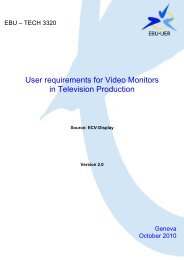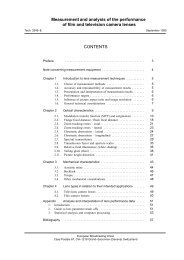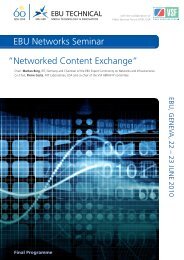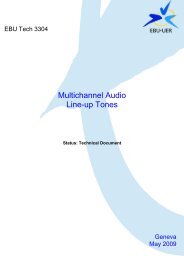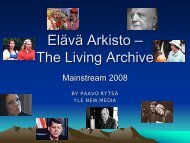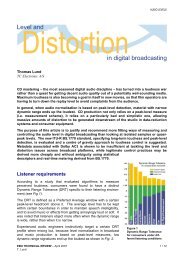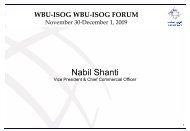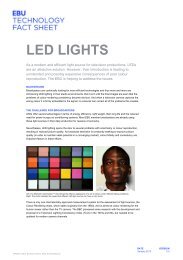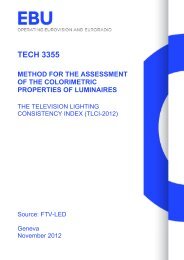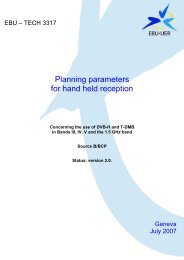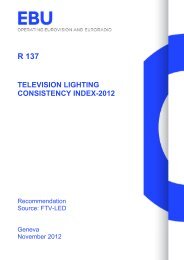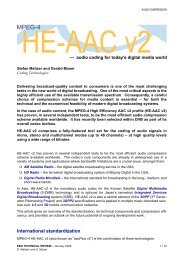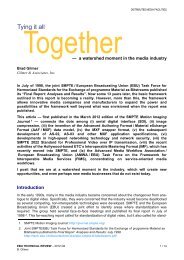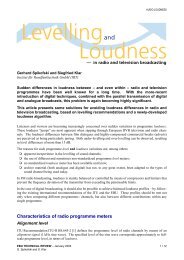Production Technology Seminar 2009 - EBU Technical
Production Technology Seminar 2009 - EBU Technical
Production Technology Seminar 2009 - EBU Technical
Create successful ePaper yourself
Turn your PDF publications into a flip-book with our unique Google optimized e-Paper software.
11<br />
WDR decided to use ARRI D-21, which offers maximum picture quality, no disadvantages in comparison<br />
to film, and a quality comparable to 35mm film. The cost saving induced by the absence of the<br />
processing of negative film allows the higher cost of the digital camera equipment rental.<br />
Workflows<br />
In the workflow with the camera D-21 directly connected to the HDCAM SR recording unit [14], the video<br />
is first down-converted to XDCAM SD for off-line editing. One can use the recorder internal look-up table,<br />
to transfer basic colour-corrected material to the postproduction suite. Audio is transferred on hard disc<br />
drives to postproduction.<br />
In the workflow with the Venom Flashpack (unfortunately 4:2:2 only, not 4:4:4) attached to the camera<br />
[15], the material data are transferred on the set to avoid to have too many Flashpacks.<br />
The postproduction workflow [16] consists of the final on-line video editing with Quantel eQ and of the<br />
audio editing on Avid Media Composer.<br />
1.5 New studio codec tests & concatenation issues<br />
Massimo Visca, Centro Centro di Produzione TV di Torino, RAI, Italy<br />
The new P/HDTV group (successor of the PMC project P/HDTP, which conducted the initial studies on<br />
HDTV in the production environments) has defined the following tasks:<br />
1 Share the experience between <strong>EBU</strong> Members (lead by <strong>EBU</strong>).<br />
2 Investigate studio compression codecs (lead by IRT).<br />
3 Analyse the performances of the lenses for HDTV cameras (lead by NRK).<br />
4 HDTV cameras and camcorders (lead by BBC).<br />
Concerning the HD production codecs, the final goal is to provide guidance and neutral information to<br />
<strong>EBU</strong> members, to help them to take their own decisions. The preliminary tasks were to:<br />
� define a test plan 10 [8] of stand alone chains (cascading of the same encoders [12]) and production<br />
chains (cascading of the same encoders [24]+[25]);<br />
� define the corresponding test conditions [13] + [26] and select reference displays [14].<br />
Concerning the requirements for HDTV codecs, it was noted that it is necessary to test them to the 7th<br />
generation, with a quality headroom mandatory in any case, because large display acts as magnifier of<br />
artefacts and archives must be usage future-proof.<br />
Picture quality is only one of the parameters to be considered in the comparison of different solutions on<br />
the market. Other key parameters are: storage requirements, network requirements, physical media<br />
bearer, error resilience, quality and cost related to use.<br />
The activity started 2 years ago [10] with the test of legacy algorithms (HDCAM, HDCAM SR,<br />
DVCPRO HD, XDCAM HD) and of 4 new algorithms (Sony XDCAM HD 422, Panasonic AVC-I, Avid<br />
DNxHD, Thomson GV JPEG2000) 11 .<br />
In November 2008 the expert viewing of the Apple ProRes422 codec was performed. The results for<br />
standalone chains of this codec are presented in the table hereafter.<br />
10 <strong>EBU</strong> BPN 076-079 Supplement, December 2007 – New HDTV Studio and Acquisition Compression System Analysis<br />
11 Cf. <strong>Production</strong> <strong>Technology</strong> seminar 2008 report - § 2.4<br />
© <strong>EBU</strong> <strong>2009</strong> / <strong>Production</strong> <strong>Technology</strong> seminar / January 27 - 29, <strong>2009</strong><br />
Reproduction prohibited without written permission of <strong>EBU</strong> TECHNICAL & <strong>EBU</strong> TRAINING


